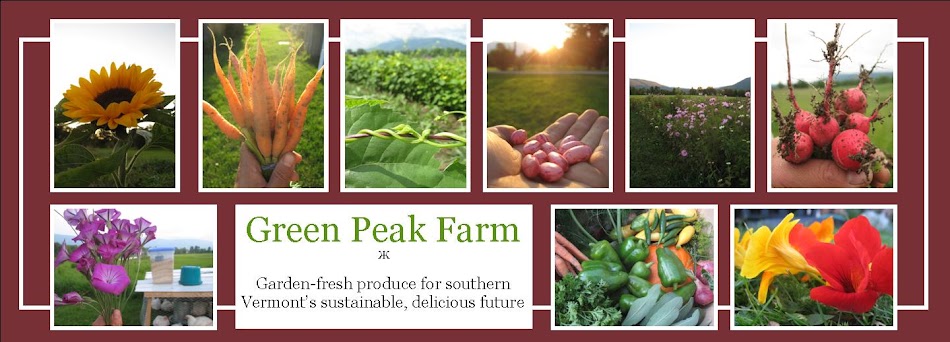 First step: before you leave the farm, make sure you know what's what in your basket!
First step: before you leave the farm, make sure you know what's what in your basket!Step two: A note on field washing-- most of your produce is field washed-- as in if it's something that will rapidly lose its quality if not rapidly cooled (think leafy greens, radishes, carrots, beets), it has been rinsed and/or soaked in potable, cold water. If it's a crop that reacts poorly to being rinsed (think summer squash, cukes, snap and snow peas, green beans), then it will come straight from the field.
Your produce will never, ever be sprayed with anything, or have harmful residues from any herbicides/pesticides. You will occassionally find a Burt hair in the mix. He is really sorry about it, but it does keep the gophers, rabbits, and other low-lying, nibbling friends at bay.
Step three: Please give your salad greens, or anything else that will be served fresh a quick rinse before eating-- in general, too, cold temps/rapid cooling help to preserve the shelf-life of veggies, converting starches to sugars. (This is part of the irony that the best-looking produce at market was often harvested the day before, and cooled overnight instead of coming fresh from the garden that morning, looking somewhat wilty at market.)
Step three-point-five: Try to remember that the occasional bug in your produce is a friendly reminder that organic farming uses overall soil health to combat pests and disease. Insects are a vital part of healthy natural communities, and they're probably just as happy to be in your lettuce as you are! Farming is not far off from being a junior entymologist.
Step four: When in doubt about how to treat an unfamiliar crop for storage in the fridge, put the crop, unwashed, into a plastic bag and leave it open. If there seem to be excess parts, trim, clip, and toss the extra surface area from which moisture is pulled by the refrigerator. The other thing to consider is, "how does this look at the grocery store?" Think about those big, 5# bags of carrots, or 1# bags of radishes-- they're good to sit on a shelf for several weeks, and they've been stripped of greens, with air holes built into the bags. All of the lovely looking greens that are convenient for holding bunches together are really conspiring against you, the eater, in drawing moisture from and dehydrating the root you'd like to eat. Toss them! (Or, sautee radish tops, use carrot tops for veggie/chix stock, and generally get creative!)
What about cilantro and parsely? The best grocery store bunches will still have their roots, unwashed, left on. Many crops survive best being chilled and unwashed (You can generally go by family here-- Cucurbits: squash, cukes, winter squash; Solanaceous/Nightshades: tomatoes, potatoes, eggplant, peppers; legumes: beans, peas, green beans, favas, edamame).
When really in doubt, please don't hesitate to contact me-- It's my sincere hope that you enjoy your produce!
One more thing: with green garlic, it's a two-for-one deal. When you get it home, lop the garlic clove (white part) up about 4-6". You can use this part just like garlic for cooking-- it's got a nice, juicy, mild flavor, or store in the fridge as is. For the upper part, hold on to the scape (flowering head) and strip the excess leaves off, then store with the rest of the scapes in an open plastic bag in the fridge.
We're getting to the end of scape season, which means they're getting a bit tougher than early on (the plants are flowering in earnest!) They're still perfectly edible, just be sure to cook them through well; if you're using them as a garlic substitute, leave 8-10 minutes of pre-cooking time before adding in more delicate veggies (like all those sugar snap peas, for example!)
And lastly, a lovely-sounding recipe passed along from Sue Claro via Bon Appetit:
[You can view the complete recipe online at: http://www.epicurious.com/recipes/food/views/366394]
Sugar Snap Salad
1 1/2 pounds sugar snap peas, trimmed, stringed, cut in half on diagonal
Kosher salt
3 tablespoons extra-virgin olive oil
1 tablespoon (or more) fresh lemon juice
1 teaspoon white wine vinegar
1/2 teaspoon sumac plus more for garnish
1 bunch radishes (about 6 ounces), trimmed, thinly sliced
4 ounces ricotta salata or feta, crumbled
Freshly ground black pepper
2 tablespoons coarsely chopped fresh mint
Ingredient info: Ricotta salata is a salted,aged ricotta cheese, available at better supermarkets and at specialty foods stores and Italian markets.
Fill a large bowl with ice water; set aside. Cook peas in a large pot of boiling salted water until crisp-tender, about 2 minutes. Drain; transfer to bowl with ice water to cool. Drain peas; transfer to a kitchen towel–lined baking sheet to dry.
Whisk oil, 1 tablespoon lemon juice, vinegar, and 1/2 teaspoon sumac in a small bowl. Toss peas, radishes, and cheese in a large bowl. DO AHEAD: Can be made 1 day ahead. Cover dressing and salad separately and chill.
Add dressing to salad and toss to coat. Season salad with salt, pepper, and more lemon juice, if desired. Garnish with mint and sprinkle with sumac.
Bon Appétit
July 2011
by Sara Dickerman
2011-06-15 16:01:38.0
Enjoy, and please pass along any good recipes, inspirations, or ideas that come along! See you next week and Happy Independence Day!

No comments:
Post a Comment